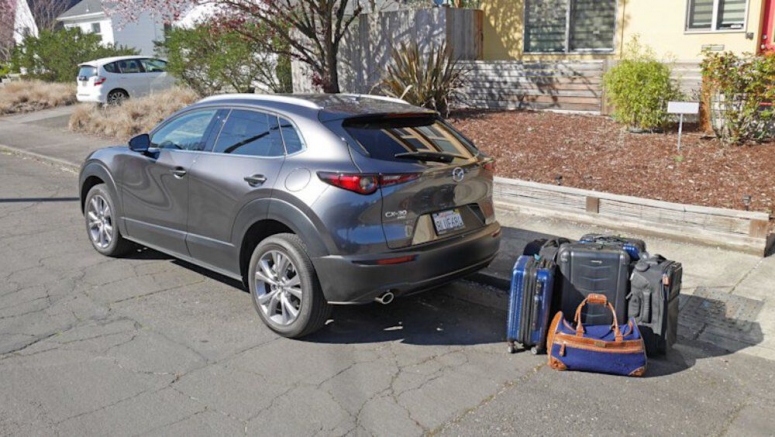Mazda Cx - 30 Cargo Capacity Test | How Much Fits In The Trunk?

The 2020 Mazda CX-30 is pretty much a lifted Mazda3 hatchback. Same platform, awfully similar dimensions, and the interior's a spitting image (if not identical). Ditto cargo capacity. On paper, the two have virtually the same amount of space behind their raised back seats, with the CX-30 at 20.2 cubic-feet and the 3 with just a teensy less at 20.1.
Now, before I go any further, let's see how much that 20.1 cubic-feet relates to in the Mazda3. I wasn't yet doing this test format back then, hence the video.
For reference, both tests used my standard luggage selection of two midsize roller suitcases that would need to be checked in at the airport (26 inches long, 16 wide, 11 deep), two roll-aboard suitcases that just barely fit in the overhead (24L x 15W x 10D), and one smaller roll-aboard that fits easily (23L x 15W x 10D). The bag of baseballs shown in the video is slightly smaller than my new small-bag go-to, my wife's fancy blue overnight bag (21L x 12W x 12D).
So, the mark to beat is therefore all the bags minus the smallest roller.
Here is what 20.2 cubic feet looks like in the CX-30. To move beyond the Mazda3 comparison, that figure is in keeping with the CX-30's niche placement between subcompact (the teens) and compact SUVs (upper 20s to upper 30s). The Mazda CX-5 has 30.9 cubic-feet.
Now, typically, I start off by seeing how much I can fit inside with the cargo cover in place. Sadly, this particular CX-30's cargo cover is missing. We'll just have to hope it doesn't rob the CX-30 of as much space as the CX-5's does.
First off, it's immediately noticed that the CX-30's cargo area is not as long as the 3 hatchback's. The largest bag just barely squeezed inside, whereas there was some room to spare in the 3.
Now, let's keep loading.
Whattya know? All of the roller bags fit inside. That includes the smallest one, which didn't fit in the 3, fitting atop the stack with perhaps 30% of it over the back seat line. Now, I could've done the same Tetris stack in the 3, but I'm virtually certain the hatch wouldn't have closed. Advantage, then, to the CX-30 and its extra height.
And surprise, the fancy bag also fits. Technically. It robs rear visibility, is pretty far above the seat line and it just barely fits under the back light. If it was filled, I have my doubts about its inclusion. Nevertheless, with or without it, there's still a bit more space on the right side for that bag of baseballs.
Now let's discuss the power liftgate. It's a resilient bugger as you can see in the video below. Clearly one of the bags would prevent it from closing on the first go, but then it seems to muster up some courage and give it another try. Good job, buddy.
Finally, as a bonus test requested by my father, who's considering the CX-30, let's see how golf clubs fit inside.
Answer: They fit diagonally, barely. Removing the driver helps as it usually does.
OK, so there you have it. But that does leave the question: How can the CX-30 carry more than the Mazda3 when the two apparently have the same amount of cargo space? Shrug emoji. Maybe I've gotten better at Tetrising bags? Maybe it's a matter of extra length (the 3) being less useful than extra height (CX-30)? Who knows, but either way, this amount of luggage is indeed superior to most subcompact SUVs, including luxury models that include the Audi Q3, Range Rover Evoque and Lexus UX (see video below). It also managed the same amount of bags as I loaded into the BMW X2, but that achieves its space by going without a spare tire. The CX-30 has a spare.
In total, better than I was expecting.



















